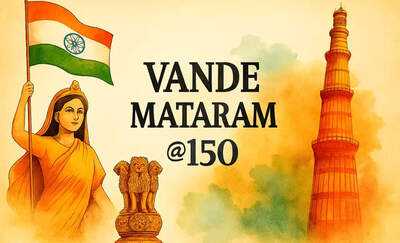Shrey Awasthi
Vande Mataram— these two sacred words have inspired a nation, uniting countless hearts and igniting the aspiration for an independent Bharat. As we commemorate 150 years of this anthem, we not only reflect on a song but also celebrate the enduring spirit of India—sacred, timeless, and ever-inspiring.
Origins of a National Anthem
In 1875, Bankim Chandra Chattopadhyay, a visionary deeply connected to India's cultural heritage, composed Vande Mataram in Sanskrit. This hymn, later featured in his novel Anandamath (1882), depicted Bharat as a divine mother, abundant in rivers, fields, and rich traditions. Amidst the oppressive colonial rule, this song rekindled the Sanatan spirit of our civilization, reminding every Indian of the sacredness of their homeland, deserving of love and protection.
The phrase Vande Mataram (I bow to thee, Mother) evolved into more than just a chant; it became a spiritual rallying cry. It invoked Shakti—the divine feminine energy—encouraging Indians to rise against tyranny and reclaim their fate. The freedom movement drew its vigor from this cultural and spiritual revival.
A Catalyst for Patriotism
When Rabindranath Tagore first performed Vande Mataram at the Indian National Congress session in 1896, it electrified the atmosphere with patriotism. The song emerged as the anthem of India's awakening. During the Swadeshi Movement of 1905, in response to the British partition of Bengal, the cry of 'Vande Mataram' resonated through streets, schools, and villages.
Students, workers, women, and revolutionaries rallied under the banner of Bharat Mata, chanting these revered words. The colonial government quaked before this unarmed weapon—a song that wielded more power than any weapon. Influential leaders like Bal Gangadhar Tilak, Bipin Chandra Pal, Lala Lajpat Rai, and Aurobindo Ghosh drew immense motivation from it, dubbing it the mantra of national awakening.
The Revolutionary Spirit
For revolutionaries such as Bhagat Singh, Chandra Shekhar Azad, and Subhas Chandra Bose, Vande Mataram represented their very identity. As they faced execution, their final words often echoed Vande Mataram.
This anthem became the battle cry for countless patriots who laid down their lives for India's freedom. Even when the British attempted to silence it by prohibiting its public recitation, the people's response was one of increased fervor. The chant of Vande Mataram grew louder, uniting India from Bengal to Punjab, Maharashtra to Tamil Nadu, under one tricolor, one mother, and one mission: Swaraj.
Symbols of Unity
As the Tiranga emerged as the emblem of a united India, Vande Mataram became its eternal melody. The saffron of the flag symbolized courage, the white represented purity, and the green embodied faith—all sentiments captured in Bankim Chandra's poetic vision. Together, they painted the image of Maa Bharati—vibrant, powerful, and divine.
Today, as we honor the Tiranga, we also pay homage to Vande Mataram—the song that breathed life into our flag. It serves as a reminder that India's freedom was not merely a political transaction but a spiritual awakening, rooted in faith, sacrifice, and Sanatan conviction.
Timeless Values and Modern Aspirations
The imagery within Vande Mataram is deeply entrenched in Sanatan philosophy—an appreciation for the earth, nature, and the divine feminine. It venerates rivers as lifelines, mountains as guardians, and the land itself as a goddess.
This ancient perspective shaped the ethos of our freedom struggle—an India that bows not to conquerors but solely to the Mother.
As the world recognizes India's ascent as a Vishwa Guru, Vande Mataram serves as a reminder of our civilizational duty—to merge contemporary progress with timeless values. This philosophy inspires the vision of New India under Prime Minister Narendra Modi, an India proud of its heritage, confident in its future, and committed to Sabka Saath, Sabka Vikas.
Reviving a People's Movement
The Vande Mataram @150 initiative by the ruling party celebrates not just history but also heritage. From national flag marches to cultural festivals, youth debates to temple events, this campaign rekindles the same passion that once ignited India with patriotic fervor.
It honors every son and daughter of Bharat who chanted Vande Mataram in the face of oppression, celebrating the eternal pride of the Tiranga. Under the guidance of the ruling party and the leadership of Modi ji, this initiative connects the youth with the spirit of their ancestors, aiming to build an India that is both modern and deeply rooted in Sanatan Dharma.
An Enduring Legacy
One hundred and fifty years have elapsed since Bankim Chandra penned those immortal lines, yet their resonance remains as potent as ever. When sung today, Vande Mataram continues to evoke a profound sense of pride, reminding us that we are the offspring of a sacred mother.
From battlefields to borders, classrooms to Parliament, temples to tech hubs—the chant of Vande Mataram unites every Indian in a shared identity, emotion, and destiny. As we celebrate 150 years of this timeless song, let us reaffirm our commitment to serve our motherland with devotion, safeguard her unity, and uphold her dignity on the global stage.
Let every Indian heart once again resonate with the pride that fueled our struggle for freedom. Let every voice rise in unison and declare with reverence and determination:
“Vande Mataram! Jai Maa Bharati! Jai Hind!”
You may also like

'Beaver Moon' lights up November sky: Stunning views captured in photos around the world

BSF foils multiple cross-border smuggling attempts along the Punjab border

AAP delegation led by Atishi meets ECI, questions simultaneous SIR and Zila Parishad polls in Goa

Land deal scrapped, Parth didn't know it was govt property, says Ajit Pawar

You will be shocked to know the signs of women's left eye twitching, know about the auspicious and inauspicious signs.







